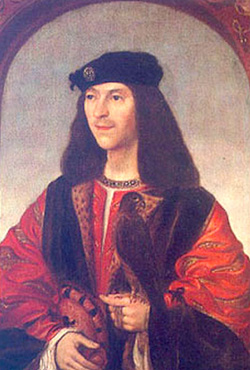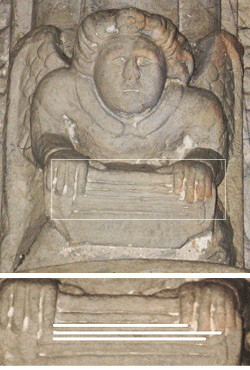The Rosslyn Code
Unearthing a hidden melody.
The Rosslyn Chapel's 213 stone cubes were carved when Leonardo da Vinci and Christopher Columbus were schoolboys. Construction on the chapel began in 1456, about 50 years before the printing press arrived in Scotland. The Stewart kings ruled the country at the time, and most historians credit James IV—who took the throne in 1488—for ushering in an era of scholarship and scientific inquiry. By that time, the chapel's founder, William St. Clair, had died, and construction on what was meant to be a much larger structure had come to a halt.
Given the era in which Rosslyn Chapel was built, then, it would be surprising to learn that someone encoded scientifically inspired symbols on the walls. But that's exactly what Tommy and Stuart Mitchell came to believe. The chapel's stone cubes, they were convinced, looked like Chladni patterns, the images that form when musical frequencies vibrate along a two-dimensional surface. Now, they just had to confront the inconvenient fact that Ernst Chladni was not born until 1756.
Chladni's date of birth didn't rule out the possibility the Mitchells had a match. Chladni patterns are a natural phenomenon, and it's entirely possible that someone else discovered them hundreds or even thousands of years before the German scientist documented them. All you need to produce these patterns is sand or salt, a flat surface, and some way to make the surface vibrate. You didn't need to be an 18th-century European to make that happen.
Besides, as far as Tommy and Stuart were concerned, they could test their hypothesis without tracking down Chladni's Scottish predecessor. If they could match each of the 12 distinct symbols repeated across the cubes to a Chladni pattern—assigning each symbol to a musical pitch—they would have a 213-note sequence. The proof would be in the melody: If it sounded like something other than an incomprehensible jumble of sound, the Mitchells would have compelling evidence that the chapel's designer had transcribed a song in Rosslyn's stone walls.
But assigning notes to the stone cubes was far from a simple task. Chladni patterns are not universal. They are specific to the shape of the vibrating plate—circular surfaces create different patterns than square ones. So in 2003, Stuart began the tedious process of comparing the designs in the chapel to a variety of Chladni diagrams. As he did so, filling in notes in the sequence piece by piece, a melody began to form in his head.
Creating a melody from scratch is a winnowing process. You have to reduce an infinite number of possibilities into a single line of notes that satisfy an arbitrary sense of what good music sounds like. Of course, the definition of "good music" has changed dramatically over time. If Stuart's melody sounded like Gershwin or Bartók, he could be pretty sure he was not on the right track—no one made those kinds of sounds in 1450. If the Rosslyn melody sounded medieval, there was a better chance he was right.
The younger Mitchell had one clue to guide him in the process. One of the four angels above what's known as the "Apprentice Pillar" was holding a strange instrument that had puzzled scholars for years. Its design was simple: a series of five strings mounted on a board, like a primitive dulcimer. But if this was a dulcimer, the angel didn't know how to play it. While such instruments sit horizontally, with the strings facing the ceiling, the stone angel holds it toward the viewer, like a guitar. This didn't make much sense, because the other 11 angels all play their instruments quite accurately, down to the violinists' fingering and the bells on the piper's wrist. It occurred to Stuart that maybe this dulcimer-like object wasn't an instrument after all. There's another meaning to five horizontal lines. Perhaps it was a musical staff.
If the staff theory is correct, it's another hint that a melody is concealed in the Rosslyn cubes—and maybe even a hint as to how that melody begins. The index finger on the angel's left hand rests on the center line—a B on a treble-clef staff. The index finger of the right hand stops at the gap between that line and the next one up—a C. The middle finger on the right hand is a bit below the middle line—an A. Even more striking is the fact that the three patterns directly above this angel's head, which are repeated in the same order elsewhere among the cubes, resemble the Chladni patterns for those same three pitches, B, C, and A. If this is a coincidence, it's a tantalizing one.
Now that he felt as if he knew the first three notes of the melody, Stuart had a much easier time extrapolating the pitches for the rest of the cubes. When he was finished, he had 213 notes that broke down into 13 short melodies of about 18 notes—one for each of the 13 arches. Stuart postulated that the angel that stands at the base of each arch is an indicator from the mystery composer as to which instrument should play which melody. That left Stuart with the equivalent of a conductor's score, with each instrument's part laid out on the same page.
Is all of this just wishful thinking? To decide for myself whether the Mitchells were on to something or whether they were just hearing what they wanted to hear, I independently coded each carving while in the Rosslyn Chapel. In all but a few cases, I categorized the symbol on the ceiling the same way the Mitchells did. There are perhaps 10 cubes out of 213 that I do not think were correctly coded, though in some cases it's really a judgment call. (Most of the cubes are remarkably preserved, but a few haven't held up as well.) Regardless, these differences aren't significant enough to make more than minor alterations to the melody. Independently matching Chladni patterns to the symbols was trickier work for all the same reasons it was tricky for the Mitchells, but I was still able to make matches for most of the cubes. In short, I don't think Tommy and Stuart have conjured a tune out of thin air.
Stuart Mitchell, too, was satisfied: After months and months of puzzling through the morass of sandstone symbols, he believed he had unlocked the secret music of the Rosslyn Chapel.
To hear piano renditions of five of Stuart Mitchell's melodies, click on the interactive feature below. These melodies (and eight others) form the basis for Mitchell's "Rosslyn Motet." Each melody was derived from a sequence of sandstone cubes that appears above a representation of an angel. The angels are depicted singing (the second melody from the top) or playing an instrument: the lute (top), the recorder (third), the shawm (fourth), and the bagpipes (fifth).






